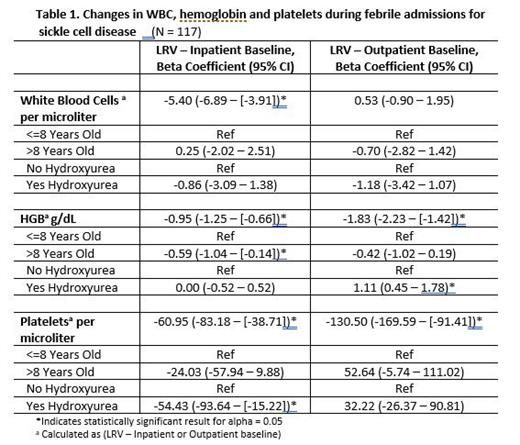Introduction: Acute splenic sequestration is a rare complication of pediatric sickle cell disease (SCD). Acute splenic sequestration crisis (ASSC) is characterized by an acute decrease in hemoglobin and is associated with an increased risk for hypovolemic shock, often requiring blood transfusion during acute episodes and splenectomy to prevent recurrent episodes. Recent studies have also shown that chronic splenomegaly and resultant anemia (described as chronic or subacute sequestration) with potential benefit of splenectomy. However, non-life-threatening splenic sequestration in febrile, hospitalized children with SCD is a frequent occurrence that has not been well-described in current literature.
Aim: To estimate the change in WBC, Hemoglobin, platelet count from inpatient and outpatient baseline to lowest recorded value (LRV) for each febrile hospitalization in sickle-cell disease patients while controlling for hydroxyurea use and patient age.
Methods: A retrospective chart review was performed on febrile, hospitalized children with a diagnosis of SCD who presented to a tertiary care hospital from 2018-2021. Data including the magnitude of fever, presence of splenomegaly and trends in laboratory parameters such as complete blood count, and chemistries were recorded. Demographics, hydroxyurea use, transfusions and sickle cell phenotype were also recorded. For our primary outcome we estimated the change in Hgb, platelets, and WBC count from inpatient (first day of hospitalization) and outpatient (most recent outpatient values) baselines to the lowest recorded value (LRV) for each hospital encounter. We employed mixed models to account for within-subject correlation and adjusted for hydroxyurea use and categorized patient age. The beta coefficient and corresponding 95% confidence interval (CI) were reported for the model intercept and predictors.
Results: Sixty-six unique patients (ages 0-17) accounted for a total of 117 hospital encounters. There was a statistically significant drop in WBC per microliter (-5.40, 95% CI: -6.89 - [-3.91]) , Hgb g/dL (-0.95, 95% CI : -1.25 - [-0.66]), and platelets per microliter (-60.95, 95% CI : -83.18 - [-38.71]) from the inpatient baseline to the LRV. There was a statistically significant drop in estimated Hgb g/dL (-1.83, 95% CI : -2.23 - [-1.42]) and platelets per microliter (-130.50, CI: -169.59 - [-91.41]) from outpatient baseline to the LRV. Hospital encounters with hydroxyurea had a significantly greater drop in estimated platelets per microliter from inpatient baseline to LRV (-54.43 CI : -93.64 - [-15.22]) but significantly greater increase in estimated Hgb g/dL from inpatient baseline to the LRV (1.11 CI : 0.45 - 1.78) compared to hospital encounters without hydroxyurea. Hospital encounters over the age of 8 were associated with a significantly greater decrease in HGB g/dL (-0.59 CI : -1.04 - [-0.14]) from inpatient baseline to the LRV compared to hospital encounters under the age of 8.
Conclusion: Our study demonstrated features consistent with acute, non-life-threatening splenic sequestration in febrile pediatric SCD patients, as evidenced by a statistically significant drop in platelets, Hgb, and WBC count from the inpatient baseline. The largest acute drop was observed in platelets, which presents the strongest argument for sequestration, as drops in Hgb may be explained by rehydration or hyperhemolysis, and changes in WBC count may be related to infection. Hydroxyurea use may delay auto-infarction of the spleen, thus predisposing to splenic sequestration at an age later than classically associated with sequestration. The preservation of splenic function probably explains greater decrease in platelet count for patients on hydroxyurea. Our study has treatment implications: children with SCD experiencing non-life-threatening acute splenic sequestration recover spontaneously without the need for blood transfusion in many cases, thus avoiding long-term complications such as RBC alloimmunization or iron overload. Also, as the drop in WBC, hemoglobin, and platelets are not due to myelosuppression, they should not lead to modification of hydroxyurea therapy. Splenectomy should be reserved for the most severe and life-threatening episodes of sequestration. Further research may assist in correlating sickle cell phenotype and history of blood transfusion with the magnitude of sequestration in this population.
Disclosures
No relevant conflicts of interest to declare.


This feature is available to Subscribers Only
Sign In or Create an Account Close Modal